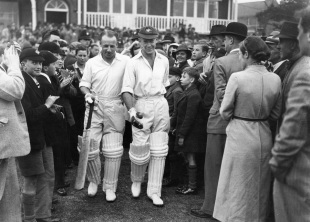Bill Brown dies aged 95
Bill Brown, who was the only remaining link to Australia's pre-World War Two Test era, died in Brisbane on Sunday at the age of 95
Cricinfo staff
17-Mar-2008

| ||
Bill Brown, who was the only remaining link to Australia's pre-World War Two Test era, has died at the age of 95. Brown was the country's oldest living Test cricketer and the third oldest in the world, and his death leaves only four surviving members of the 1948 Invincibles squad - Arthur Morris, Sam Loxton, Neil Harvey and Ron Hamence. His health had steadily declined in the past few months and he died peacefully at an RSL home in Brisbane's northern suburbs on Sunday.
Although Brown's career was often overshadowed by his better-known contemporaries - he played with the likes of Don Bradman, Bill Ponsford, Bill Woodfull and Stan McCabe - he was without doubt a first-rate opening batsman. His 22 Tests brought 1592 runs at 46.82 and he was given the honour of captaining Australia for their first Test after the war.
He formed a prolific combination with Jack Fingleton and the pair averaged 63.75 in their opening stands in ten Tests. They were at their most damaging on the 1935-36 tour of South Africa, when they compiled three century partnerships including 233 in Cape Town, which remains a record for the first wicket in Australia-South Africa Tests.
Brown's personal pinnacle came at Lord's on the 1938 Ashes tour, when he carried his bat for an unbeaten 206 in the first televised Test, a match that was also memorable for Wally Hammond's 240. He had already scored 133 at Trent Bridge and he had such a successful tour that he was second only to Bradman in Australia's list of aggregates and averages, and his 512 Test runs at 73.14 earned him a Wisden Cricketer of the Year award for 1939.
A cautious opener, Brown took seriously the job description, which he later summarised as: "Stay there until lunch-time on the first day. The pace you scored at didn't matter a darn." His adherence to the team request might not have pleased all the fans, who were often left waiting for the appearance of Bradman at No. 3, but it did satisfy his team-mates and Australia won 14 of the 22 Tests in which Brown played.
His three tours to England were all memorable for different reasons - he made his Test debut in 1934 in Nottingham and scored 73, which was followed by his maiden century in the next match at Lord's. The 1938 visit earned him the Wisden honour, and ten years later he returned and at the age of 35 played two Tests during the Invincibles trip.
By then his best days were behind him but he went on to play one more Australian summer as the captain of Queensland, his home state. Although he was born in Toowoomba in 1912, Brown had learned his cricket in New South Wales and made his first-class debut there in 1932-33.
That was the season of Bodyline and in the lead-up to the fourth Test Brown got a taste of his international future when he played against the tourists for a New South Wales side. Brown, who was only 20, enjoyed the occasion by making 69 when Bradman, Fingleton and Alan Kippax all failed. "The grass looks greener, it's a lovely day, the sun's shining, I wouldn't be anywhere else in the world," Brown said in later years in the book Remembering Bradman, recalling how he felt when he discovered England were resting Harold Larwood, Gubby Allen and Bill Voce.
"Prior to that I'd been lying in bed at night worrying. I had a fairly heavy bat, you see, and I'd thought, God, I'll never get this up in time for Larwood, he'll hit me fair between the eyes and that'll be the end of me."
During World War II, Brown was an air-force pilot and he spent time serving in Darwin and New Guinea, so his recollections of the conflict were markedly different to those of his team-mate Keith Miller, who flew over Germany. "I class mine as a gentleman's war," Brown said. "Never got dirty doing anything."
Brown went on to become a selector for Queensland and Australia during the 1950s, and in later years he was known as a gentleman of Australian cricket and as an entertaining public speaker. He presented Adam Gilchrist and Scott Muller with their baggy-green caps in 1999 and repeated the occasion six years later at the Gabba when Michael Hussey debuted. Brown inherited the mantle as Australia's oldest living Test cricketer from Bradman and that title has now passed to Hamence, who at 92 is one of the four remaining Invicibles.